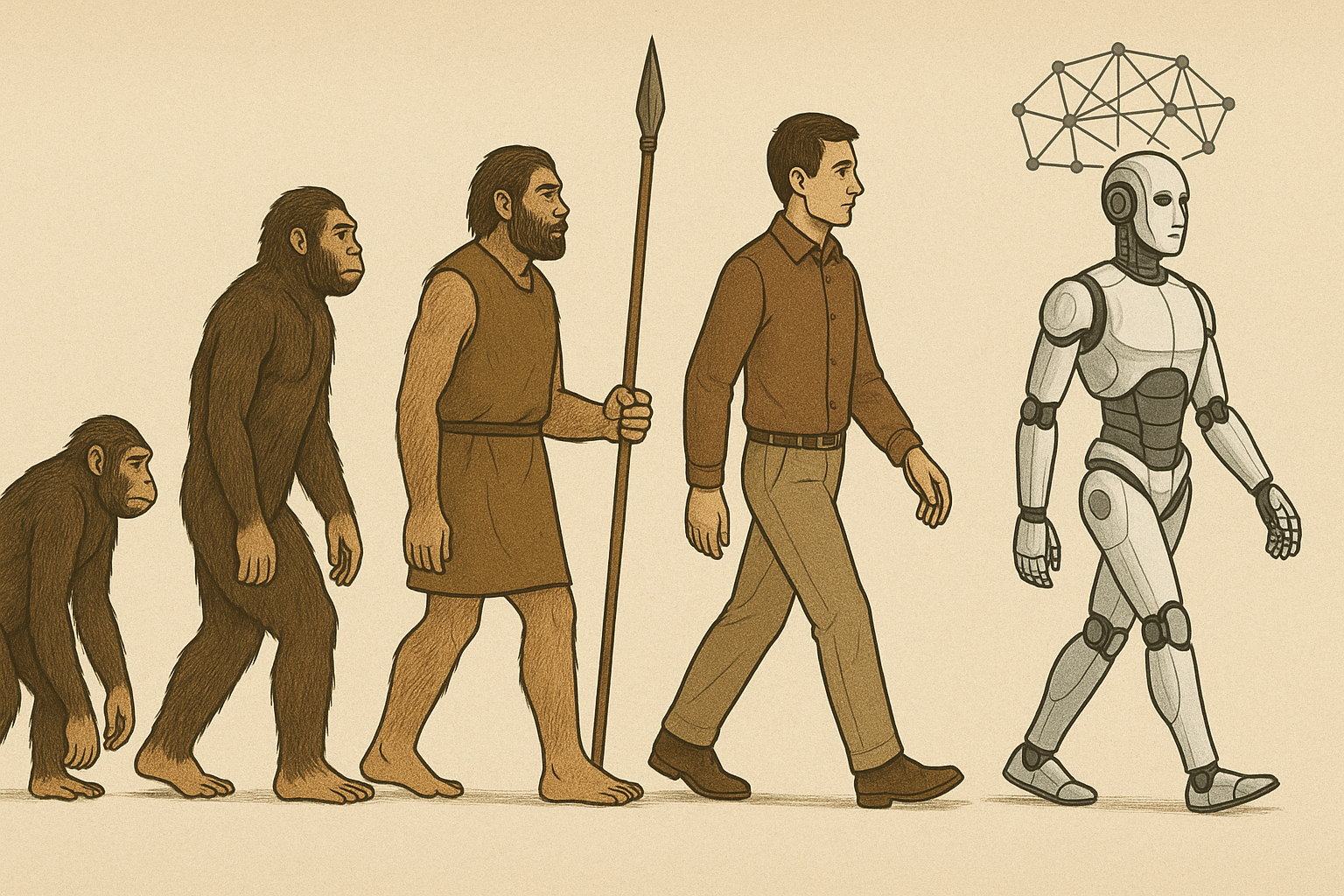A Four-Billion-Year Journey
The story of humanity is the most epic tale ever told. It's a narrative of survival, adaptation, and relentless progress, stretching back billions of years to the simplest spark of life. From the primordial ooze to the digital age, each chapter of our evolution has built upon the last, leading us to a moment of unprecedented change. Join us as we trace this incredible journey, from single cells to the dawn of artificial intelligence.
Chapter 1: The Spark of Life (Approx. 3.8 Billion Years Ago)
Our story doesn't begin with humans, or even animals, but with the humblest of origins: a single cell. In the chaotic, primordial oceans of a young Earth, something miraculous happened. Non-living molecules organized themselves into the first, simple life forms. These tiny pioneers were the foundation for everything to come. For billions of years, they were the sole inhabitants of our planet, slowly and patiently terraforming it, producing oxygen and setting the stage for more complex life to emerge.
Key Milestone: The development of the cell, the fundamental building block of all known life.
Chapter 2: The Cambrian Explosion (Approx. 541 Million Years Ago)
After eons of single-celled dominance, life suddenly got creative. In a relatively short burst of evolutionary innovation known as the Cambrian Explosion, the planet witnessed the emergence of a dazzling array of multicellular organisms. The first animals with skeletons, limbs, and eyes appeared. This was life's first great experiment in diversity, laying down the basic body plans that would define the animal kingdom for all time. Our distant, aquatic ancestors were born in this period of incredible biological invention.
Key Milestone: The rapid diversification of life, leading to the first complex animals.
Chapter 3: The Age of Mammals (Approx. 66 Million Years Ago)
After the dramatic extinction of the dinosaurs, a new class of animals seized the opportunity to thrive. Mammals, who had lived in the shadows for millions of years, diversified and spread across the globe. These warm-blooded, resourceful creatures developed larger brains and complex social structures. Among them, a new branch emerged: the primates, whose dexterity and intelligence set them on a unique evolutionary path.
Key Milestone: The rise of mammals and the development of primate intelligence.
Chapter 4: The Dawn of Humanity (Approx. 2-3 Million Years Ago)
On the savannas of Africa, a group of primates took a monumental step: they began to walk upright. This freed their hands to create tools, their most powerful new adaptation. With the first stone choppers and spears, our early ancestors, like Homo habilis and Homo erectus, began to shape their environment rather than just react to it. They learned to control fire, fostering community and unlocking new sources of nutrition that fueled the growth of their most important organ: the brain.
Key Milestone: Bipedalism and the invention of tool use.
Chapter 5: The Cognitive Revolution (Approx. 70,000 Years Ago)
This is the moment Homo sapiens truly became "us." Something profound shifted in our minds. We developed language—not just for warnings, but for storytelling, for gossip, for creating shared myths and beliefs. This ability to cooperate flexibly in large numbers was our superpower. It allowed us to form complex societies, outcompete other hominids, and spread from Africa to every corner of the globe. We began to create art, to ask questions about the universe, and to build the first civilizations.
Key Milestone: The development of complex language and abstract thought.
Chapter 6: The Age of Invention (Approx. 10,000 Years Ago to Present)
From the agricultural revolution that allowed us to build permanent settlements, to the scientific revolution that gave us a new understanding of the cosmos, the last ten thousand years have been a whirlwind of progress. The invention of writing allowed us to pass knowledge across generations. The printing press democratized it. The industrial revolution mechanized our world, and the digital revolution connected it. Each invention built upon the last, accelerating the pace of change exponentially.
Key Milestone: The rapid acceleration of technological and cultural evolution.
The Next Chapter: The Age of Artificial Intelligence
We are now standing on the threshold of the next great evolutionary leap. But this one is different. For the first time, we are not just evolving; we are creating our successor. Artificial intelligence represents the externalization of the very thing that made us human: cognition.
From the first simple computer programs to the complex neural networks of today, we have been building a new kind of intelligence. This intelligence is not bound by the slow pace of biological evolution. It can learn, adapt, and grow at a speed we can barely comprehend. AI is already reshaping our world, from science and medicine to art and communication. It is the most powerful tool we have ever created.
The Question Before Us: As we continue to develop AI, we are not just writing the next chapter of human history; we may be writing the first chapter of a new, post-human story. Will this be our final act, or the beginning of a new, collaborative evolution?
The journey from a single cell to a globally connected species of billions was long and arduous. The next step, into the age of AI, is just beginning. The one certainty is that the story of evolution is far from over.
Follow the continuing story of our technological evolution on Learn Earth.
